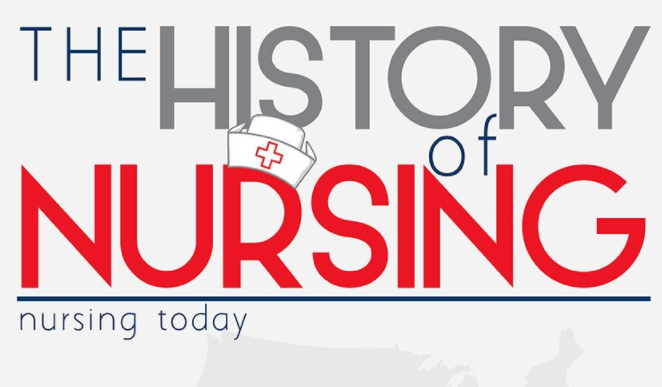History of Nursing Infographic
The History of Nursing summarized in an infographic from the first recorded nurse to the present day is informative and easy to understand!

The History of Nursing
Today:
There are over 2.9 million nurses in America
Or one for every 102 Americans
Caring for over 8 million Americans a day.
Nurses per 10,000 people around the world:
Africa: 11
Americas: 61
South-East Asia: 13
Europe: 75
Eastern Mediterranean: 15
Western Pacific: 20
United Kingdom: 103
America: 98
Canada: 101
Australia: 96
World: 30
Adding $7 billion in economic value.
Just in medical savings and increased patient productivity
They provide valuable services
EXECUTING medical regimes prescribed by doctors
ASSISTING through in-depth medical assessments
TEACHING patients and families on health procedures
MANAGING restorative and palliative care
PARTICIPATING in research
EMBRACING ethical obligations of patient/healthcare provider relations
But it wasn’t always that way
The first recorded nurse:
Phoebe a deaconess was sent to Rome by Paul to nurse both men and women.
Romans 16:1-3
“I commend to you our sister Phoebe, who is a servant of the church which is at Cenchrea;that you receive her in the Lord in a manner worthy of the saints, and that you help her in whatever matter she may have need of you; for she herself has also been a helper of many, and of myself as well.”
165-180 AD: Christian nurses won friends caring for the sick of the smallpox epidemic.
325 AD: “It’s the Christian thing to do”
Unlike pagans before, the First Council of Nicea started the construction of a hospital in every cathedral town.
Earliest include:
Caesarea (Turkey)
And Constantinople
Which included housing for nurses and doctors
A separate section for lepers.
Space for medical and pharmacological studies.
A chief physician, professional nurses, and orderlies.
580 AD: Merida, Spain
A xenodochium was established.
An inn for travelers +
a hospital for citizens and local farmers
700’s-800’s: Emperor Charlemagne decrees old hospitals in decay be restored.
800’s: Islamic hospital at Kairouan, Tunisia founded.
Had a waiting room as well as male nurses for male patients, and female nurses for female patients.
900’s: Convents and Monasteries became central to healthcare.
Nuns occupied prestigious positions. Were often from wealthy families who funded convents to help provide healthcare for the poor.
1100’s: Carmelites: Still extant Catholic order that cares for the sick created.
1200’s: Dominican and Franciscan Orders created who also has a long lineage of nursing the sick.
1500’s: Protestant Reformation
Protestant reformers shut down monasteries and convents.
Some hospitals continued in government hands.
1600-1800: Nursing ranks dissipated as women were forced to remain at home.
1639: Canadian Augustine nuns establish the first nursing apprenticeship in North America.
1836: First deaconess house opened.
Deaconesses:
Women pledged themselves to 5 years of service for the room, board, uniforms, pocket change, and lifelong care.
Florence Nightingale and Modern Era
By 1957:
[number of deaconesses by nation]
Germany: 46,000
US & Canada: 1550
Other Nations: 17,000
Late 1800’s: Nightingale’s Britain
Florence Nightingale lays the foundations of professional nursing in her book Notes on Nursing
1860: Queen Victoria opens the Royal Victoria Hospital to train medical caretakers and provide for soldiers.
Nurses accompanied troops to field hospitals in the:
First Boer War (1879-1881)
Egyptian Campaign (1882)
Sudan War (1883-1884)
…
With close to 2000 nurses serving in the Anglo-Boer War of 1889-1902
Canada
1874: General and Marine Hospital in St. Catharines General Hospital in Ontario starts training nurses.
This leads to a push for:
licensing legislation
nursing journals
university training
professional organizations
Emily Stowe (1831-1901): First female doctor to practice in Canada.
Augusta Stowe-Gullen (1857-1943): Stowe’s daughter, the first woman to graduate from Canadian Medical School.
France
1870: 1500 hospitals were run by 11,000 Catholic Sisters
1911: 15,000 nuns from over 200 religious orders running the healthcare system.
America
1873: Linda Richards graduates as America’s first professionally trained nurse in Boston.
1881: American Red Cross was started by Clara Barton, a famous Civil War-era nurse known as the “angel of the battlefield.”
Early 1900’s: Hospitals took over schools, favoring clinical experience over “book learning” and using students as cheap labor.
Hospital Growth:
1873: 149 hospitals
1910: 4,400 hospitals
1933: 6,300 hospitals
With active graduate nurses growing rapidly:
1910: 51,000
1940: 375,000
1970: 700,000
World War II transformed nursing in America.
With 1 nurse for every 10 soldiers
And 600,000 soldiers.
In his final “fireside chat” President Roosevelt–fearing heavy casualties in the invasion of Japan called for a compulsory draft of nurses.
Citations:
- https://www.nursezone.com/nursing-news-events/more-news/Study-Highlights-the-Economic-Value-of-Nurses_28842.aspx
- https://www.jacksonvilleu.com/media/1497463/average-day-nursing-infographic.png
- https://www.op.nysed.gov/prof/nurse/nursebroch.htm
- https://biblehub.com/romans/16-2.htm
- https://archive.org/stream/historyofthedeac00golduoft/historyofthedeac00golduoft_djvu.txt
Related:






